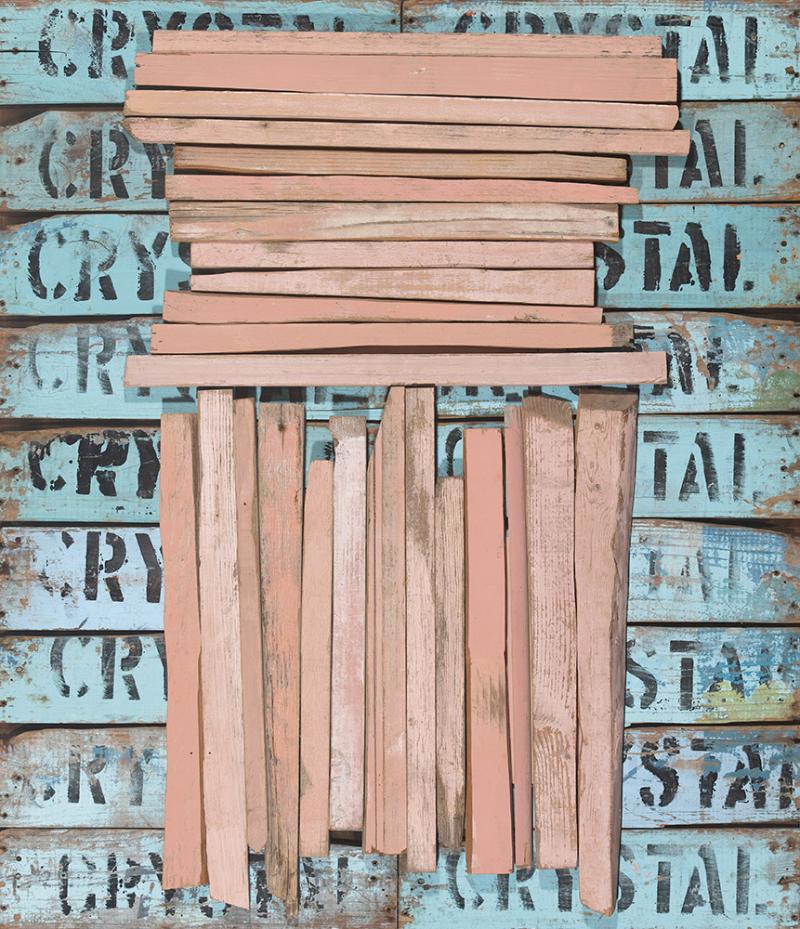ROSALIE GASCOIGNE (1917-1999)
Pink on Blue 1982-83
Estimate: $100000 - 150000
Sold For:
$90,000 hammer
Description
ROSALIE GASCOIGNE (1917-1999)
Pink on Blue 1982-83
soft drink crates on plywood
101.0 x 87.0 cm
signed, dated and inscribed verso: PINK ON BLUE/ 1982-83/ ROSALIE GASCOIGNE
Provenance:
Joseph Brown Collection, Melbourne
Private collection, Melbourne
Deutscher-Menzies, Sydney, 12 September 2007, lot 34
Private company collection, Melbourne
Deutscher-Menzies, Sydney, 25 March 2009, lot 43
Company collection, Melbourne
Reference:
Thomas, D., Outlines of Australian Art: The Joseph Brown Collection, Macmillan, Melbourne, 3rd edition, 1980, p.71 (illus., pl.363)
Estimate: $100000 - 150000
Result Hammer: $90,000
I am not making pictures, I make feelings. I want to make art without telling a story; it must be allusive, lyrical.1
Rosalie Gascoigne’s work is refreshingly original and unique in the context of Australian art. Simultaneously simple yet complex, her contemporary assemblages are highly personal responses to the landscape and as Deborah Edwards, the curator of Gascoigne’s major survey exhibition explains, these assemblage benefit from her ‘use of modernist strategies, her … means of construction, those of fragmentation, re-assemblage, repetition, tessellation and compression.‘2
Gascoigne’s departure in 1943 from the abundantly lush landscape of Auckland, New Zealand, was sharply contrasted with her arrival to the infinitely dry, parched plains of Canberra, Australia. The immersion in such a starkly foreign environment created a greater sense of awareness of the landscape surrounding her, and in time, the landscape was to become the central theme underpinning her oeuvre.
Gascoigne found life as a wife and mother at the small isolated Mt. Stromolo scientific community to be quite lonely, so she commenced classes in the Japanese art of Ikebana. She soon became frustrated by the limitations of Ikebana and made the transition to undertake her own compositions. These initial assemblages were created from discarded objects found in nearby paddocks and reflected Gascoigne’s new surrounds in Monaro. Rosalie’s husband, Ben Gascoigne, recalled, ‘What she did was to construct assemblages from objects which had been shaped by natural processes like bleaching, ageing, weathering, and decay. Her materials were strictly regional- very much of the Monaro. She found them in Monaro paddocks and rubbish dumps, old cottages, abandoned mines and river banks. Her inspiration came from the Monaro too, but what she tried to convey was not so much the appearance of our local countryside, rather its feeling - the response it aroused in the viewer.’3
Pink on Blue is a classic example of work from the highly sought- after soft-drink crate series, which benefited from the maturation of the early assemblages. Both potent and evocative, the work encapsulates the spirit of the Monaro region. Here, discarded and faded remnants of blue soft-drink crates and weathered pink ply are stoic survivors of a disposable society, gently re-configured and balanced together with renewed purpose and meaning. By incorporating recycled local materials and reflecting local experiences and visions in her work, Gascoigne engendered her work with a gritty integrity. Of such assemblages, Edmund Capon, Director of the Art Gallery of New South Wales noted, ‘The combination of the humility of the found objects from which they are made and the innate wisdom and sensitivity of their re-assembly conveys a sense of inalienable truth.’4
In this most accomplished piece, the recurring label, ‘Crystal’, acts primarily to reinforce the work’s horizontal-vertical structure, especially when juxtaposed against the horizontal and vertical clusters of the pink ply. The letters and word fragments stacked in grid-like formation, so typical of Gascoigne’s work of the period, were suggestive of a crossword, a subtle reference to her daily passion for the crossword in the Canberra Times.5 Alongside works such as Scrub Country, 1982, Pink on Blue is a closely related precursor to works such as the epic Monaro, 1989, in the collection of the Art Gallery of Western Australia.
Notably, Pink on Blue was commenced in 1982, the same year in which Gascoigne received the prestigious honour of being the first woman to represent Australia at the Venice Biennale. The appointment was one of a number of major accolades and achievements accrued by the artist over her exceptional 25 year career as a professional artist. Today Gascoigne’s work can be found in all major state galleries and many regional collections, in addition to international institutions such as the National Art Gallery, Wellington and the Metropolitan Museum of Art,
New York.
Footnotes
1. Rosalie Gascoigne in conversation with Max Cullen, Sunday, Nine network, July 12 1998
2. Edwards, D., Rosalie Gascoigne: Material as Landscape, AGNSW, Sydney, 1998, p.11
3. Ben Gascoigne in interview with Professor Bob Crompton, www.science.org.au/scientists/interviews/g/bg.html. 2000
4. Edmund Capon, Preface, in Edwards, D., Rosalie Gascoigne: Material as Landscape, AGNSW, Sydney, 1998, p.5
5. Macdonald, V., Rosalie Gascoigne, Regaro, Sydney, 1998, p.35
Marina Bromley BA (Hons)
Location
SYDNEY VIEWING. 17 - 20 October 11am - 6pm. 12 Todman Avenue, Kensington
MELBOURNE VIEWING. 24 - 30 October 11am - 6pm. Stonnington Mansion, 336 Glenferrie Rd, Malvern
